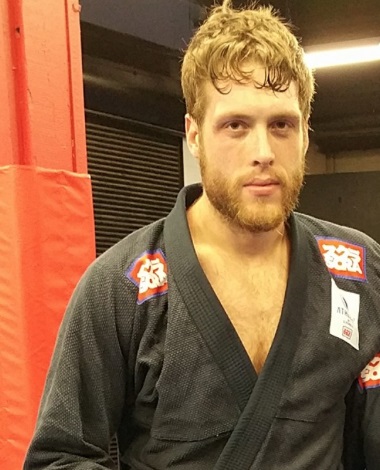Big man, small man jiu jitsu
I started training almost three years ago, and while I’ve lost a lot of weight since beginning, I’ll always be large—especially for someone who practices Brazilian Jiu- Jitsu, an art developed to suit the combative needs of those less gifted in strength and stature.
All body types come with a certain set of challenges, but often overlooked are the obstacles that larger people face when they start training. Will you be able to submit the rooster weight blue belt within your first few weeks of training because you muscled an Americana while suffocating them in mount? Maybe. Will you have an easier time taking down your physically weaker training partners? Possibly. Will you feel as though you’re progressing faster because your white belt peers lack the technique to counter your superior strength? Most likely.
None of this, however, constitutes someone who is good at Jiu-Jitsu, and trying to depend too much on your physical gifts can stunt your growth as a iiujitsero. Smaller people come to Jiu-Jitsu class with no option but to learn technique, and that size disadvantage creates an impetus to be more detail oriented. With larger people, however, it’s important that we allow our physical gifts to shine brightest through the lens of proper technique. Here are some ways that I have figured out how to do this:
Start in Guard More Often
One of the core concepts of Brazilian Jiu Jitsu is the guard, so developing it is crucial, especially for the larger people in the gym, because you’re less likely to end up there during rolls.
If you’re going to start on the ground, have one partner work their passing game, and have one work their guard. If you’re the larger of the two practitioners, voluntarily sit on the ground and work your guard. You’re not gaining anything by being part of a muscle war where both partners are on their knees trying to bench-press the other into kesa-gatame. Be conscious of this, and if you catch yourself doing it, disengage and sit in open guard. If you get passed, it’s not a big deal; your guard will be better in the long term than if don’t take that approach.
Learn to Flow Roll with Smaller Training Partners
It hasn’t happened often, but people have turned me down during open mats because they didn’t want to risk injury by rolling with someone who has a clear size advantage. These grievances, however, will go away if you agree to roll less aggressively with your smaller training partners. It will also allow you to slow your thinking down and work parts of your game that you’re having trouble with. Both sides win, essentially; you get to develop a more cerebral approach to your training, and your training partners that weigh one hundred-something pounds can roll with you without fear of suffering injury.
Remind Yourself that It Isn’t About Strength
As much as Jiu-Jitsu endorses the idea of setting aside your ego, it’s nearly impossible to do so entirely. There’s always someone better than you, unless you’re Roger Gracie, but I doubt he’s reading this.
Because of this, it can be easy to fall into the trap of thinking that you’re progressing faster because you’re able to “beat” your white belt peers in every roll. I put the aforementioned verb in quotes for a reason; there’s no such thing as a roll that you lose or win, but it’s difficult to align yourself with that thinking at the start of your journey. And if you’re two hundred-something pounds and a white belt, you likely roll a lot like I and most every other large person rolled when they started—pure beast mode, with extra strength.
While it can bolster your confidence in the short term, you’re crippling your development. There will come a time when your smaller training partners learn to sweep and get on top of you, and there will be a time when you won’t be able to bench press them off of you. When this happens, it’s important to have spent time on the bottom, so you can escape, counter-sweep, or establish guard.
I’ve rolled with several heavier grapplers, and it’s shocking to see how many heavier practitioners–even at advanced ranks, like purple belt– lack the technical facility to escape a bad position. This is indicative of someone who fell into the trap set by their own physical prowess.
Final Thoughts
Jiu-Jitsu is a long road, and your progress can be analogous with a stock market graph—an unpredictable and often infuriating fluctuation. Worse, if you implement these concepts into your training, you might notice a dip in the short term. But if you persist, you’ll see that the macro-level trend was upward.




